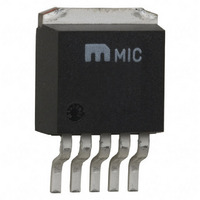MIC39300-1.8BU TR Micrel Inc, MIC39300-1.8BU TR Datasheet - Page 10

MIC39300-1.8BU TR
Manufacturer Part Number
MIC39300-1.8BU TR
Description
IC REG LDO 3A 1.0% 1.8V TO-263
Manufacturer
Micrel Inc
Datasheet
1.MIC39300-1.8WU.pdf
(13 pages)
Specifications of MIC39300-1.8BU TR
Regulator Topology
Positive Fixed
Voltage - Output
1.8V
Voltage - Input
2.5 ~ 16 V
Voltage - Dropout (typical)
0.385V @ 3A
Number Of Regulators
1
Current - Output
3A (Min)
Operating Temperature
-40°C ~ 125°C
Mounting Type
Surface Mount
Package / Case
TO-263-3, D²Pak (3 leads + Tab), TO-263AA
Lead Free Status / RoHS Status
Contains lead / RoHS non-compliant
Current - Limit (min)
-
Other names
MIC39300-1.8BUTR
MIC39300-1.8BUTR
MIC39300-1.8BUTR
Application Information
The MIC39300/1/2 are high-performance, low-dropout
voltage regulators suitable for moderate to high-current
voltage regulator applications. Its 550mV dropout
voltage at full load makes it especially valuable in
battery-powered systems and as a high-efficiency noise
filter in post-regulator applications. Unlike older NPN-
pass transistor designs, where the minimum dropout
voltage is limited by the base-to-emitter voltage drop and
collector-to-emitter
performance of the PNP output of these devices is
limited only by the low V
A trade-off for the low dropout voltage is a varying base
drive requirement. Micrel’s Super βeta PNP
reduces this drive requirement to only 2% to 5% of the
load current.
The MIC39300/1/2 regulators are fully protected from
damage due to fault conditions. Current limiting is
provided. This limiting is linear; output current during
overload conditions is constant. Thermal shutdown
disables the device when the die temperature exceeds
the maximum safe operating temperature. Transient
protection allows device (and load) survival even when
the input voltage spikes above and below nominal. The
output structure of these regulators allows voltages in
excess of the desired output voltage to be applied
without reverse current flow.
Thermal Design
Linear regulators are simple to use. The most
complicated design parameters to consider are thermal
characteristics. Thermal design requires four application-
specific parameters:
• Maximum ambient temperature (T
• Output Current (I
• Output Voltage (V
• Input Voltage (V
• Ground Current (I
Calculate the power dissipation of the regulator from
these numbers and the device parameters from this
datasheet, where the ground current is taken from the
data sheet.
The heat sink thermal resistance is determined by:
where T
The heat sink may be significantly reduced in
applications where the minimum input voltage is known
and is large compared with the dropout voltage. Use a
series input resistor to drop excessive voltage and
Micrel, Inc.
October 2009
P
J(max)
θ
D
SA
= (V
=
≤ 125°C and θ
T
J
IN
(max)
– V
P
IN
D
OUT
−
GND
OUT
)
OUT
T
A
saturation
)
)
)
) I
CE
−
(
OUT
θ
saturation voltage.
JC
CS
+
+ V
θ
is between 0° and 2°C/W.
CS
IN
)
× I
A
voltage,
)
GND
®
process
dropout
10
distribute the heat between this resistor and the
regulator. The low dropout properties of Micrel Super
βeta PNP
regulator power dissipation and the associated heat sink
without compromising performance. When this technique
is employed, a capacitor of at least 1.0μF is needed
directly between the input and regulator ground.
Refer to “Application Note 9” for further details and
examples on thermal design and heat sink specification.
Output Capacitor
The MIC39300/1/2 requires an output capacitor to
maintain stability and improve transient response.
Proper capacitor selection is important to ensure proper
operation. The MIC39300/1/2 output capacitor selection
is
resistance) of the output capacitor to maintain stability.
When the output capacitor is 47μF or greater, the output
capacitor should have less than 1Ω of ESR. This will
improve transient response as well as promote stability.
Ultralow ESR capacitors, such as ceramic chip
capacitors may promote instability. These very low ESR
levels may cause an oscillation and/or underdamped
transient response. A low-ESR solid tantalum capacitor
works extremely well and provides good transient
response and stability over temperature. Aluminum
electrolytics can also be used, as long as the ESR of the
capacitor is < 1Ω.
The value of the output capacitor can be increased
without limit. Higher capacitance values help to improve
transient response and ripple rejection and reduce
output noise.
Input Capacitor
An input capacitor of 1μF or greater is recommended
when the device is more than 4 inches away from the
bulk ac supply capacitance, or when the supply is a
battery. Small, surface mount, ceramic chip capacitors
can be used for the bypassing. Larger values will help to
improve ripple rejection by bypassing the input to the
regulator, further improving the integrity of the output
voltage.
dependent
Figure 1. Capacitor Requirements
®
regulators allow significant reductions in
upon
the
ESR
MIC39300/39301/39302
(equivalent
M9999-102309-A
series














